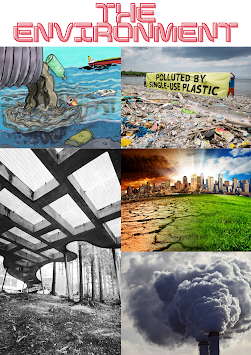Environment
includes living things, non-living things.
Environment
defines as - The combination of external physical conditions that affect and
influence the growth, development, behaviour, and survival of organisms.
Global warming
has become an undisputed fact about our current livelihoods; our planet is
warming up and we are definitely part of the problem. However, this isn’t the
only environmental problem that we should be concerned about. All across the
world, people are facing a wealth of new and challenging environmental problems
every day. Some of them are small and only affect a few ecosystems, but others
are drastically changing the landscape of what we already know.
If a human
being keeps the environment safe and secure then environment keeps the human
being safe and secure. There is a saying that What you give you get in
return. Life is an ECHO, it s life cycle.
Now-a-days many
depends on cement to build houses, malls etc. It’s became a concrete park which
is causing major impact to the environment, Concrete causes damage to the most
fertile layer of the earth.
The
Environmental Impacts of Concrete - https://www.greenspec.co.uk/building-design/environmental-impacts-of-concrete/#:~:text=The%20Environmental%20Impacts%20of%20Concrete%20Cement%20and%20global,total%20of%20CO2emissions%20is%20caused%20by%20cement%20production
An environmental disaster
or ecological disaster is defined as a catastrophic event regarding the natural
environment that is due to human activity. Environmental disasters show how the
impact of humans alteration of the land has led to widespread and/or
long-lasting consequences. These disasters have included deaths of wildlife,
humans and plants, or severe disruption of human life or health, possibly
requiring migration.
Few of the people plant trees to
decorate their gardens with beauty or to provide the extra shade in summer. But
there are many benefits from trees than what that we might think like reducing
climate change, purifying air, colling down the streets, natural air
conditioning, saving water, preventing water pollution, providing shelter for
animals and many more.
Pollution is also another cause
for the extinction of animals. It usually enters through the atmosphere, earth,
or some body of water. Chemicals can enter the air, water, and soil when they
are produced, used or disposed. Pollution from chemicals can cause animals to
become weakened, or can even cause death. It can also cause problems in the
food chain too like bio-accumulation. Bioaccumulation is the gradual
accumulation of substances, such as pesticides or other chemicals, in an
organism.
Carbon dioxide can be used as a
carbon source for many small chemicals that are used to make everyday items. chemicals
are then used in other processes to make compounds like polyethylene, which you
might find in everyday plastic items. Plastic leads to destroying the marine
life and polluting the earth. Millions of tons of plastic are in the
environment as waste, especially in the oceans and seas. More than 80% of
marine litter is plastic which kills up to 1 million seabirds and 100,000
marine creatures each year by ingesting it. Carbon dioxide is a naturally
occurring greenhouse gas. … An increase in the amount of carbon dioxide creates
an an excessive quantity of greenhouse gases that trap additional heat. This
trapped heat leads to melting ice caps and rising ocean levels, which cause
flooding.
A sweeping report assessing the
state of the natural world found that humans are having an “unprecedented” and
devastating effect on global biodiversity, with about 1 million animal and
plant species now threatened with extinction.
The report, which did not list
individual species, found that 25 percent of mammals, more than 40 percent of
amphibian species, nearly 33 percent of sharks and 25 percent of plant groups
are threatened with extinction. Based on these proportions, the researchers
estimated that approximately 1 million animal and plant species could die out,
many “within decades.”
Environmental protection is a
practice of protecting the natural environment on the individual,
organizational or governmental levels, for the benefit of both the environment
and humans. Environmentalism, a social and environmental movement, addresses
environmental issues through advocacy, education and activism.
#environment, #chemicals, #floods,
#disasters, #animalsextinction, #naturalenvironment, #human, #carbondiaoxide,
#pollution, #planttree, #wildlife, #plastic, #consequences,
#environmentaldisaster, #lifeisanecho, #protectenvironment, #globalwarming,
#concretepark, #earthquakes, #venu, #dvg, #venuguptha, #atmosphere, #mammals, #individualspieces,
#humanactivities, #facebook, #linkedin, #pinterest, #twitter, #blogging,
#articles, #blogs, #blogger, #wordpress, #instagram,


Comments
Post a Comment